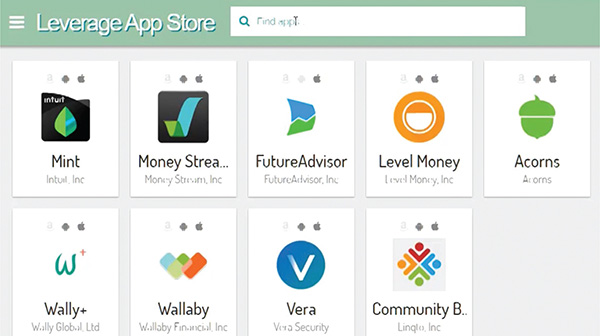If credit unions can't beat the fintechs, why not join ’em?
That's what nine credit unions in New York, Florida and Alabama are doing in a six-month pilot project with LEVERAGE, the for-profit subsidiary of the League of Southeastern Credit Unions, and Linqto, a Silicon Valley company that specializes in software for fintech applications.
The short-term goal of the pilot project is for credit unions to work with fintech developers to determine what specific apps are most likely to appeal to existing and prospective millennial members.
The long-term goal of the project is to help fintech companies monetize their apps and enable credit unions to use popular unbundled, or single-function, apps – an emerging trend among young consumers, who find these apps more convenient and easier to use.
The centerpiece of the pilot project, launched in April, is the LEVERAGE app store, which features white-label fintech apps such as Mint, Money Stream, FutureAdvisor, Level Money, Acorns, Wallaby, Wally+ and Vera.
But unlike the Apple, Android and Amazon app stores, the LEVERAGE app store is exclusively powered by Linqto's patent-pending software platform, Otter.
According to Linqto, it has developed a first-of-its-kind platform that enables credit unions to select popular fintech apps and upload their customized brands within those apps to market to their members and prospective members.
Developing, testing and implementing an app - something that used to take a financial institution six months - can now take six minutes, according to Linqto.
The Otter platform enables both fintech companies and credit unions to achieve two important goals, Linqto said.
“Fintech apps are having a problem in monetizing [their apps],” Linqto CEO Bill Sarris said. “They may have been successful in attracting the millennial market, but their apps had to be free in the Apple store. Developers have realized they can't charge for their apps. It's the kiss of death. In our system, credit unions pay for the branding and usage rights of an individual app. Then the developer keeps 70% and the app store keeps 30%, but the consumer doesn't pay anything for the app.”
 Sarris previously worked as a senior technology engineer and consultant for Mint, QuickBooks, QuickBooks Online, Intuit Paper Trail, Intuit Partner Platform and Intuit websites. His development experience included web, iOS, Android and desktop versions of Intuit products.
Sarris previously worked as a senior technology engineer and consultant for Mint, QuickBooks, QuickBooks Online, Intuit Paper Trail, Intuit Partner Platform and Intuit websites. His development experience included web, iOS, Android and desktop versions of Intuit products.
Patrick LaPine, president/CEO of the Southeastern league and LEVERAGE, said Linqto is contributing millions of dollars to support the pilot project. About half of that amount will be committed to helping credit unions market and promote the apps to members and millennials. LEVERAGE has also earmarked resources to support the pilot project.
Linqto selected the Southeastern league because of its diverse demographics in Alabama, Florida and New York. Last year, the Southeastern league forged a collaborative partnership with the New York Credit Union Association and invited cooperatives from the Empire State to participate in the pilot project.
The New York credit unions involved in the pilot are the $6.6 billion Bethpage Federal Credit Union in Long Island, the $979 million CFCU Community Federal Credit Union in Ithaca and the $78 million Inner Lakes Federal Credit Union in Westfield. The Florida cooperatives are the $724 million First Florida Credit Union in Jacksonville, the $176 million Members First Credit Union of Florida in Pensacola, the $79 million Buckeye Community Federal Credit Union in Perry and the $75 million Sun Credit Union in Hollywood. The Alabama credit unions are the $705 million Alabama Credit Union in Tuscaloosa and the $573 million Family Security Credit Union in Decatur.
“I think this is a great opportunity for us to learn from a fintech company, to learn about their processes, how they go about product development and how they conduct pilot programs,” LaPine said. “It's like going to fintech school for six months.”
Every Thursday morning, Linqto executives, fintech developers and credit union executives hold a phone conference to discuss mobile apps and exchange ideas about how they can be used in the marketplace.
“What is wonderful about it is how both sides are willing to cooperate,” Sarris said. “They really want this to happen. So many great ideas come up from both sides about how developers can slightly modify their apps so they could be more advantageous to credit union members.”
For example, one recent phone conference focused on the Wallaby app, which tells consumers as they shop which credit card can offer the most rewards, the best interest rate and the lowest fees, and offers other financial data.
“Part of the discussion we had recently was how can an app be modified in a credit union's market when millennials download the Bethpage-branded Wallaby app, for example,” he explained. “If they aren't a member of Bethpage, the credit union's Visa card would come up and show them that if they would use the credit union's card, they would get more rewards or a better interest rate than other cards.”
 An “apply now” button in the app would show the benefits of the card in real time and invite young consumers to become members of the credit union to reap more benefits.
An “apply now” button in the app would show the benefits of the card in real time and invite young consumers to become members of the credit union to reap more benefits.
“These are some of the general conversations that are going on that are focused on how you use new fintech apps to attract new members and not just provide additional services,” Sarris said.
Throughout the pilot project, the credit unions will test the apps and determine which ones appeal to members and prospective members.
“When you get to the end of this, there is no one credit union that is going to have 200 apps – one credit union might have two, three or four,” he said. “The pilot program is very hands-on to make sure this happens successfully by the time we get to the general launch of the LEVERAGE app store.”
Credit unions participating in the pilot project have also inquired about fitness, lifestyle and gaming apps as another way to attract young members.
“There are all different kinds of apps that can come into play because when you think of the phone screen, it's become like the new marketplace or the new billboard,” he said. “If you have one monolithic banking app like most banks and credit unions have, you probably have 12 to 15 different features in it and you have to go through 14 different screens in the app to get to what you want. But that isn't how mobile apps work, and it's why traditional banking has lost the millennial marketplace.”
As a result, more companies are unbundling their multifunctional apps and creating single-function apps.
For example, American Express features several single-function apps that help their customers manage business receipts, collect reward points from other retailers they shop at, and experience a cinematic, interactive Taylor Swift music experience.
The new unbundled app trend stems from the fact that it is much easier and less time consuming for consumers to click on one single-function app to get their tasks done, Sarris noted.
He said one credit union came up with the idea of branding a popular gaming app and using it to start a consumer competition for three months. Whoever scored the highest number of points would receive a $1,000 prize from the credit union.
“I think we are getting great ideas, simply marketing ideas that have nothing to do with fintech, but it's all about attracting the millennial market and bringing them into the credit union membership,” he said.
© 2025 ALM Global, LLC, All Rights Reserved. Request academic re-use from www.copyright.com. All other uses, submit a request to [email protected]. For more information visit Asset & Logo Licensing.








